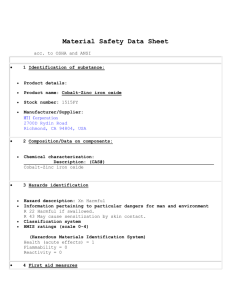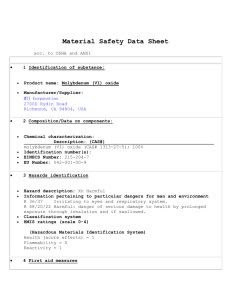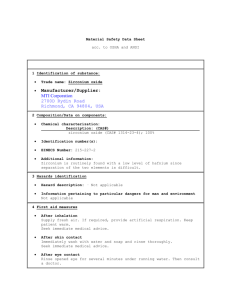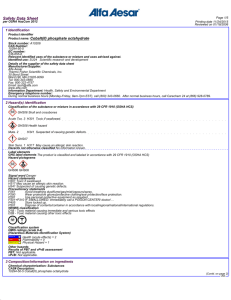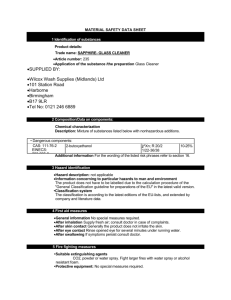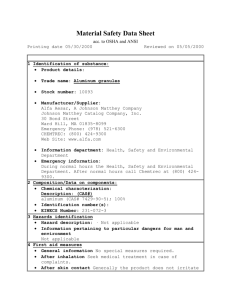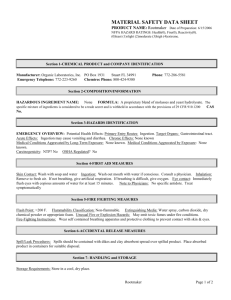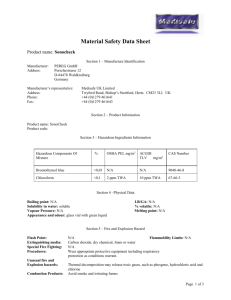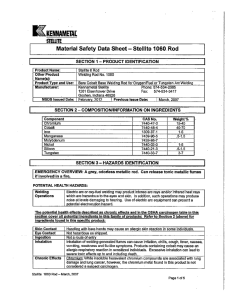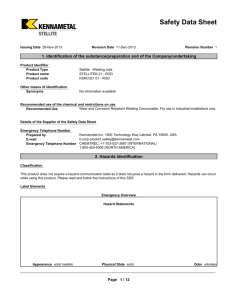Cobalt (II) phosphate, octahydrate
advertisement
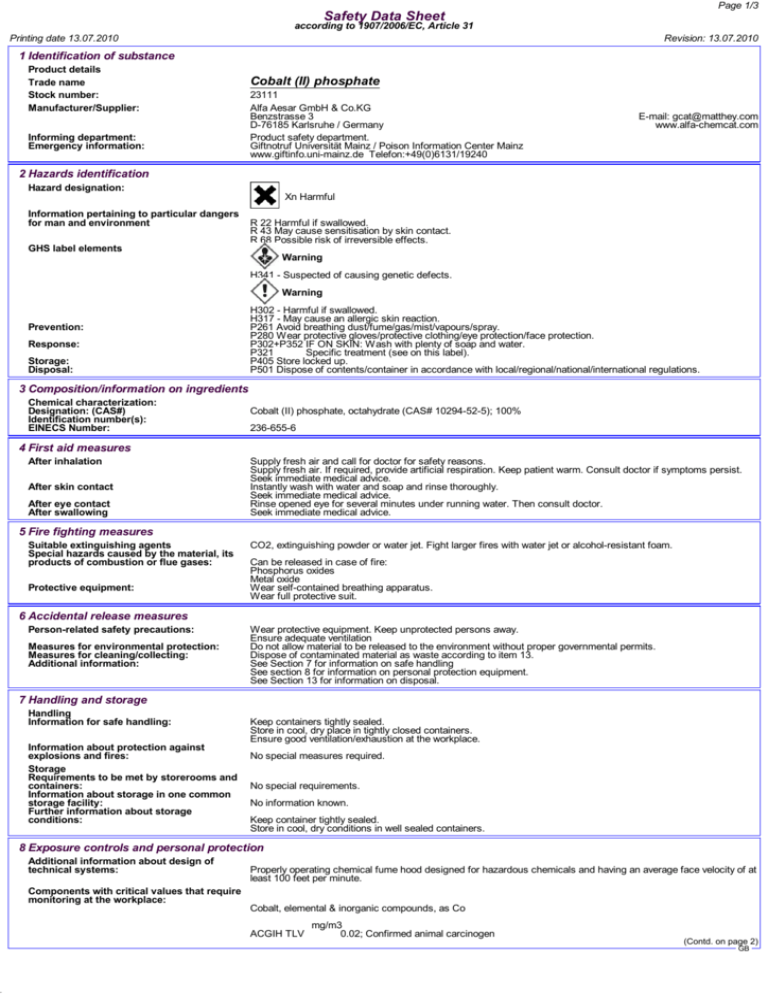
DR Page 1/3 Safety Data Sheet according to 1907/2006/EC, Article 31 Printing date 13.07.2010 Revision: 13.07.2010 1 Identification of substance Product details Trade name Stock number: Manufacturer/Supplier: Informing department: Emergency information: Cobalt (II) phosphate 23111 Alfa Aesar GmbH & Co.KG Benzstrasse 3 D-76185 Karlsruhe / Germany Product safety department. Giftnotruf Universität Mainz / Poison Information Center Mainz www.giftinfo.uni-mainz.de Telefon:+49(0)6131/19240 E-mail: gcat@matthey.com www.alfa-chemcat.com 2 Hazards identification Hazard designation: Xn Harmful Information pertaining to particular dangers for man and environment GHS label elements R 22 Harmful if swallowed. R 43 May cause sensitisation by skin contact. R 68 Possible risk of irreversible effects. Warning H341 - Suspected of causing genetic defects. Warning Prevention: Response: Storage: Disposal: H302 - Harmful if swallowed. H317 - May cause an allergic skin reaction. P261 Avoid breathing dust/fume/gas/mist/vapours/spray. P280 Wear protective gloves/protective clothing/eye protection/face protection. P302+P352 IF ON SKIN: Wash with plenty of soap and water. P321 Specific treatment (see on this label). P405 Store locked up. P501 Dispose of contents/container in accordance with local/regional/national/international regulations. 3 Composition/information on ingredients Chemical characterization: Designation: (CAS#) Identification number(s): EINECS Number: Cobalt (II) phosphate, octahydrate (CAS# 10294-52-5); 100% 236-655-6 4 First aid measures After inhalation After skin contact After eye contact After swallowing Supply fresh air and call for doctor for safety reasons. Supply fresh air. If required, provide artificial respiration. Keep patient warm. Consult doctor if symptoms persist. Seek immediate medical advice. Instantly wash with water and soap and rinse thoroughly. Seek immediate medical advice. Rinse opened eye for several minutes under running water. Then consult doctor. Seek immediate medical advice. 5 Fire fighting measures Suitable extinguishing agents Special hazards caused by the material, its products of combustion or flue gases: Protective equipment: CO2, extinguishing powder or water jet. Fight larger fires with water jet or alcohol-resistant foam. Can be released in case of fire: Phosphorus oxides Metal oxide Wear self-contained breathing apparatus. Wear full protective suit. 6 Accidental release measures Person-related safety precautions: Measures for environmental protection: Measures for cleaning/collecting: Additional information: Wear protective equipment. Keep unprotected persons away. Ensure adequate ventilation Do not allow material to be released to the environment without proper governmental permits. Dispose of contaminated material as waste according to item 13. See Section 7 for information on safe handling See section 8 for information on personal protection equipment. See Section 13 for information on disposal. 7 Handling and storage Handling Information for safe handling: Information about protection against explosions and fires: Storage Requirements to be met by storerooms and containers: Information about storage in one common storage facility: Further information about storage conditions: Keep containers tightly sealed. Store in cool, dry place in tightly closed containers. Ensure good ventilation/exhaustion at the workplace. No special measures required. No special requirements. No information known. Keep container tightly sealed. Store in cool, dry conditions in well sealed containers. 8 Exposure controls and personal protection Additional information about design of technical systems: Components with critical values that require monitoring at the workplace: Properly operating chemical fume hood designed for hazardous chemicals and having an average face velocity of at least 100 feet per minute. Cobalt, elemental & inorganic compounds, as Co ACGIH TLV mg/m3 0.02; Confirmed animal carcinogen (Contd. on page 2) GB DR Page 2/3 Safety Data Sheet according to 1907/2006/EC, Article 31 Printing date 13.07.2010 Trade name Cobalt Revision: 13.07.2010 (II) phosphate (Contd. of page 1) Additional information: Personal protective equipment General protective and hygienic measures Breathing equipment: Eye protection: Body protection: Austria Carcinogen Belgium TWA 0.05 Denmark TWA 0.05 Finland TWA 0.05 (skin) Germany Carcinogen Hungary TWA 0.1; 0.2-STEL Japan OEL 0.05; 2B-Carcinogen Korea TLV 0.02; Confirmed animal carcinogen Netherlands MAC-TGG 0.05 Norway TWA 0.05 Poland TWA 0.05; 0.2-STEL Russia 0.5-STEL Sweden NGV 0.05 Switzerland MAK-W 0.1; Carcinogen United Kingdom TWA 0.1 USA PEL 0.1 (dust and fume) No data The usual precautionary measures should be adhered to in handling the chemicals. Keep away from foodstuffs, beverages and food. Instantly remove any soiled and impregnated garments. Wash hands during breaks and at the end of the work. Use breathing protection with high concentrations. Safety glasses Protective work clothing. 9 Physical and chemical properties: General Information Form: Colour: Smell: Change in condition Melting point/Melting range: Boiling point/Boiling range: Sublimation temperature / start: Flash point: Ignition temperature: Decomposition temperature: Danger of explosion: Critical values for explosion: Lower: Upper: Steam pressure: Density at 20°C Solubility in / Miscibility with Water: Powder Pink Violet Odourless 200°C ((-8H2O)) Not determined Not determined Not applicable Not determined Not determined Product is not explosive. Not determined Not determined Not determined 2.769 g/cm³ Slightly soluble 10 Stability and reactivity Thermal decomposition / conditions to be avoided: Materials to be avoided: Dangerous reactions: Dangerous products of decomposition: No decomposition if used and stored according to specifications. None known. No dangerous reactions known Phosphorus oxides (e.g. P2O5) Metal oxide 11 Toxicological information Acute toxicity: LD/LC50 values that are relevant for classification: Oral LD50 539 mg/kg (rat) Primary irritant effect: on the skin: Irritant for skin and mucous membranes. on the eye: Irritant effect. Sensitization: Sensitization possible by skin contact. Additional toxicological information: To the best of our knowledge the acute and chronic toxicity of this substance is not fully known. IARC-2B: Possibly carcinogenic to humans: limited evidence in humans in the absence of sufficient evidence in experimental animals. ACGIH A3: Animal carcinogen: Agent is carcinogenic in experimental animals at a relatively high dose, by route(s) of administration, at site(s), of histologic type(s), or by mechanism(s) not considered relevant to worker exposure. Available epidemologic studies do not confirm an increased risk of cancer in exposed humans. Available evidence suggests that the agent is not likely to cause cancer in humans except under uncommon or unlikely routes or levels of exposure. Sensitisation May cause sensitisation by skin contact. 12 Ecological information: Additional ecological information: General notes: Water hazard class 1 (Self-assessment): slightly hazardous for water. Do not allow undiluted product or large quantities of it to reach ground water, water bodies or sewage system. Do not allow material to be released to the environment without proper governmental permits. 13 Disposal considerations Product: Recommendation Uncleaned packagings: Recommendation: Consult state, local or national regulations for proper disposal. Hand over to disposers of hazardous waste. Must be specially treated under adherence to official regulations. Disposal must be made according to official regulations. (Contd. on page 3) GB DR Page 3/3 Safety Data Sheet according to 1907/2006/EC, Article 31 Printing date 13.07.2010 Trade name Cobalt Revision: 13.07.2010 (II) phosphate (Contd. of page 2) Recommended cleaning agent: Water, if necessary with cleaning agent. 14 Transport information Land transport ADR/RID and GGVS/GGVE (cross-border/domestic) ADR/RID-GGVS/E Class: None Maritime transport IMDG/GGVSea: IMDG/GGVSea Class: None Marine pollutant: No Air transport ICAO-TI and IATA-DGR: ICAO/IATA Class: None Transport/Additional information: Not dangerous according to the above specifications. 15 Regulatory information Designation according to EC guidelines: Code letter and hazard designation of product: Xn Harmful Risk phrases: Safety phrases: National regulations Information about limitation of use: Water hazard class: 22 Harmful if swallowed. 43 May cause sensitisation by skin contact. 68 Possible risk of irreversible effects. 36/37 Wear suitable protective clothing and gloves. Employment restrictions concerning young persons must be observed. For use only by technically qualified individuals. Water hazard class 1 (Self-assessment): slightly hazardous for water. 16 Other information: Employers should use this information only as a supplement to other information gathered by them, and should make independent judgement of suitability of this information to ensure proper use and protect the health and safety of employees. This information is furnished without warranty, and any use of the product not in conformance with this Material Safety Data Sheet, or in combination with any other product or process, is the responsibility of the user. Department issuing data specification sheet: Health, Safety and Environmental Department. Contact: Zachariah Holt ADR: Accord européen sur le transport des marchandises dangereuses par Route (European Agreement concerning the International Carriage of Abbreviations and acronyms: Dangerous Goods by Road) RID: Règlement international concernant le transport des marchandises dangereuses par chemin de fer (Regulations Concerning the International Transport of Dangerous Goods by Rail) IMDG: International Maritime Code for Dangerous Goods IATA: International Air Transport Association IATA-DGR: Dangerous Goods Regulations by the "International Air Transport Association" (IATA) ICAO: International Civil Aviation Organization ICAO-TI: Technical Instructions by the "International Civil Aviation Organization" (ICAO) GHS: Globally Harmonized System of Classification and Labelling of Chemicals EINECS: European Inventory of Existing Commercial Chemical Substances CAS: Chemical Abstracts Service (division of the American Chemical Society) LC50: Lethal concentration, 50 percent LD50: Lethal dose, 50 percent GB
